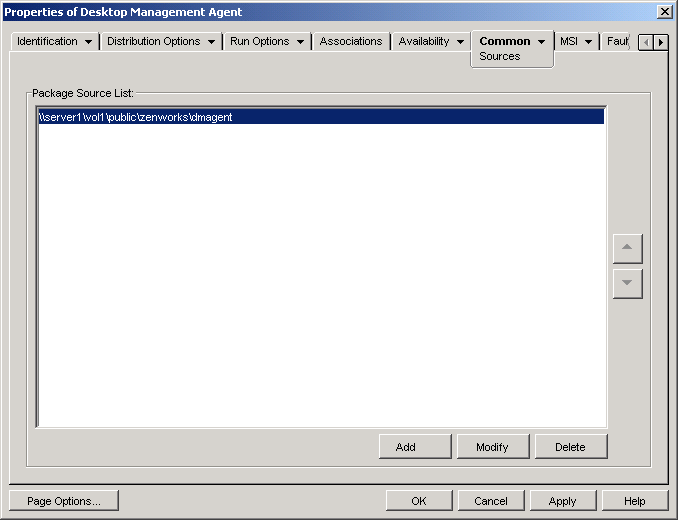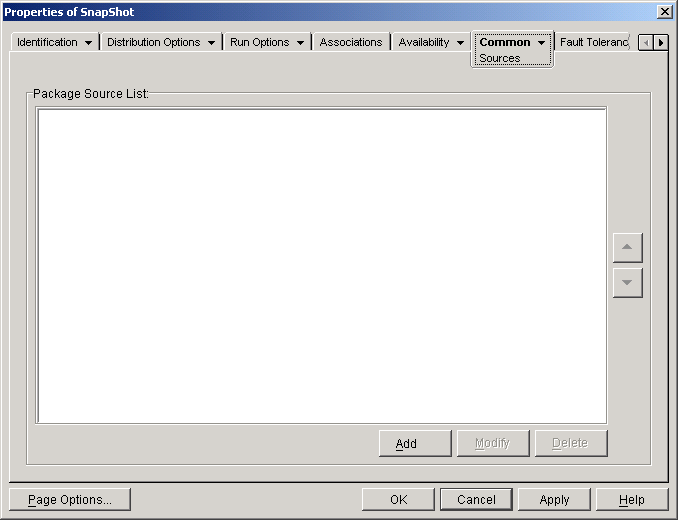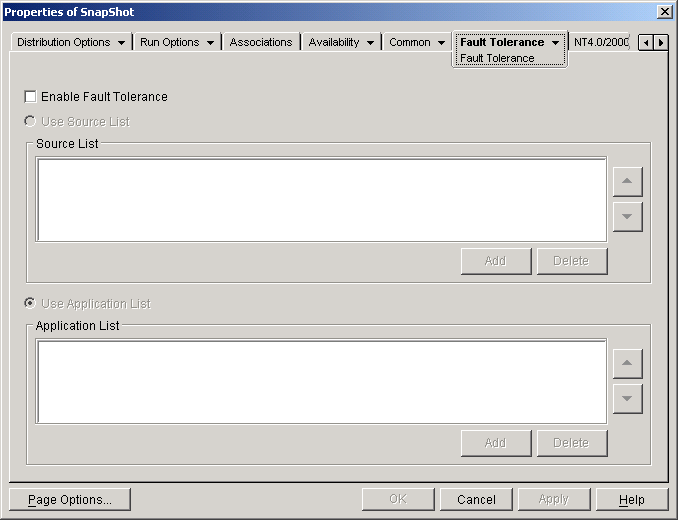36.1 Setting Up Fault Tolerance
Network problems can make installation packages unavailable. To ensure that an application can be distributed even when its installation package is unavailable, you can establish backup installation packages. How you do so depends on the type of application, as explained in the following sections:
ZENworks Desktop Management does not provide fault tolerance for Web applications or terminal server applications.
36.1.1 Setting Up Fault Tolerance for MSI Applications
You establish fault tolerance, or source resiliency, for an MSI application by having multiple installation packages available at different server locations. During distribution, if the first source fails, Application Launcher attempts to distribute from an alternate source.
To set up fault tolerance for an MSI application:
-
Create the additional MSI installation packages in the server locations you want.
-
In ConsoleOne®, right-click the MSI Application object for which you want to establish fault tolerance, then click to display the Application object's property pages.
-
Click the tab > to display the Sources page.

By default, the Sources page displays the source location that was specified when the MSI Application object was created.
-
Click , specify the source path for an MSI installation package, then click to add the additional source to the list.
-
Repeat Step 4 until you've added all available sources.
-
Use the arrow buttons to list the sources in the order you want them used.
The first source listed is used first, the second is used next, and so forth until either the distribution is successful or all sources have been used.
-
Click to save your changes.
36.1.2 Setting Up Fault Tolerance for Simple or AOT/AXT Applications
You establish fault tolerance for a simple application or an AOT/AXT application by having multiple installation packages at different source locations. During distribution, if the application's first source fails, Application Launcher attempts to distribute from an alternate source.
When setting up fault tolerance for an application, you can link directly to additional installation packages or you can link to additional Application objects that have been created using the installation packages. For example, you want to set up fault tolerance for App1, whose installation package is located at \\server1\vol1\public\zenworks\app1. You create three additional source locations:
- \\server2\vol1\public\zenworks\app1
- \\server3\vol1\public\zenworks\app1
- \\server4\vol1\public\zenworks\app1
You can define each of the additional installation packages as sources for App1, or you can create three new Application objects using each of the installation packages and then have App1 link to the three new Application objects.
Defining each of the additional installation packages as sources for App1 has the advantage of requiring configuration of only one Application object. Regardless of which installation package is used, the App1 object's distribution settings are applied.
Defining additional Application objects using the installation packages enables you to have different Application object configuration settings for each installation package. If you choose to use additional Application objects rather than additional sources, please be aware of the following limitations:
-
Only one-level-deep fault tolerance is supported. If Application Launcher fails over to a backup Application object and the backup Application object fails, the distribution fails even if fault tolerance has been enabled for the backup Application object.
-
and distributions do not support fault tolerance through Application objects. Both of these distributions require Application Launcher to copy installation package files to the workstation cache and then install from the cache, which requires the use of additional sources rather than additional Application objects.
To set up fault tolerance for a simple application or an AOT/AXT application:
-
Copy the additional installation packages to the server locations you want.
-
(Conditional) If you plan to create Application objects for each of the additional installation packages so that you can link to the Application objects, create the Application objects. If necessary, refer to Section 28.2, Configuring the Application in eDirectory.
-
In ConsoleOne, right-click the Application object for which you want to establish fault tolerance, then click to display the Application object's property pages.
-
(Conditional) If you are using installation packages only (no Application objects for them), define the installation packages as additional sources for the application. To do so:
-
Click the tab > to display the Sources page.

-
Click , specify the source path for an installation package, then click to add the additional source to the list.
-
Repeat Step 4.b until you've added all available sources.
-
-
Click the tab > to display the Fault Tolerance page.

-
Fill in the following fields:
Enable fault tolerance: Select this option to enable fault tolerance. The other fault tolerance options are available only if this option is enabled.
Use source list: Select this option to have Application Launcher use a list of sources as the backup. You must have already created at least one installation package source (see Step 4).
To add a source to the Source List, click , browse to and select the source, then click .
To remove a source, select the source from the Source List, then click .
If distribution of the application fails, Application Launcher tries the alternate sources in the order they are listed, from top to bottom. To change the order of the sources, select a source from the Source List, then click the up-arrow to move the source up in the list or click the down-arrow to move it down in the list.
Use application list: Select this option to have Application Launcher use Application objects as the backup installation packages. You must have already created additional Application objects for the application, with the installation package being stored on a different server or volume than this application (see Step 2).
To add an Application object to the Application List, click , browse to and select the Application object, then click .
To remove an Application object from the list, select the Application object, then click .
If distribution of the application fails, Application Launcher tries the Application objects in the order they are listed, from top to bottom. To change the order of the list, select an Application object from the Application List, then click the up-arrow to move the Application object up in the list or click the down-arrow to move it down in the list.
-
Click to save your changes.